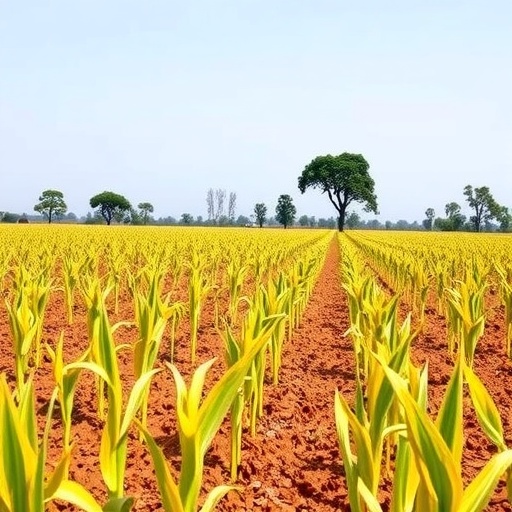In the evolving landscape of agricultural technology, machine learning is proving to be a game changer in enhancing crop yield forecasts. This is particularly significant for countries like Senegal, where agricultural output plays a crucial role in the economy and food security. The research led by a team of scientists including Seck, Ngom, and Ngom presents a thorough analysis of the application of various machine learning methods tailored specifically for crop yield forecasting in Senegal. As they delve into the intricacies of how these advanced techniques can be employed to predict agricultural productivity, the implications extend far beyond the fields.
The crux of the research focuses on identifying patterns and factors that drive crop yields. Traditional farming techniques, while rooted in centuries of experience, often lack the precision and adaptability required in today’s fast-evolving climate. Machine learning, on the other hand, leverages vast amounts of data—from weather patterns to soil conditions—to create more accurate models for predicting crop outcomes. This study aims to harness such technologies to offer actionable insights to farmers, policy makers, and stakeholders in the agricultural sector.
One of the major breakthroughs in this research is the integration of diverse data sources. The authors employed satellite imagery, climatic data, and soil characteristics, merging these seemingly disparate elements into a cohesive predictive model. By utilizing such an extensive dataset, the team could train machine learning algorithms to identify correlations and trends that might go unnoticed through conventional methods. This holistic approach not only enhances the accuracy of forecasts but also empowers farmers to make more informed decisions regarding crop management.
Importantly, the study acknowledges the unique challenges faced by Senegalese farmers, including unpredictable weather patterns and limited access to resources. By customizing machine learning techniques to the local context, this research paves the way for practical applications that address these specific issues. For instance, using predictive models, farmers could determine the best times for planting and harvesting, which is essential in a region where the growing season is often affected by erratic rainfall patterns.
The research also sheds light on the potential economic benefits of improved yield forecasting. As farmers adopt these machine learning methods, they stand to increase their productivity significantly. Enhanced crop yields can lead to surplus production, which not only benefits individual farmers but can also bolster national food security. Moreover, with better forecasting abilities, market dynamics may stabilize, allowing for more predictable income streams for farmers and reducing food price volatility.
In terms of technical implementation, the study elaborates on the specific machine learning algorithms employed. Techniques such as regression analysis, decision trees, and neural networks were explored for their effectiveness in predicting the variables influencing crop yields. Each method was meticulously evaluated, and the researchers emphasize the importance of selecting the appropriate model based on the nature of the data and the specific crops being studied.
The role of technology in agriculture is not merely about increasing yields; it also encompasses sustainability. The authors highlight how machine learning can assist in promoting more ecologically sound agricultural practices. By accurately predicting outcomes, farmers could optimize resource usage—minimizing water consumption and reducing chemical fertilizers—thus nurturing a more sustainable farming landscape. These insights could serve as a template for other regions grappling with similar challenges, promoting a broader global movement toward sustainable agriculture.
As the global population continues to rise, so does the urgency to innovate within the agricultural sector. The implications of this research extend beyond immediate crop yield improvements, as it represents a shift toward data-driven agricultural practices capable of addressing long-term challenges. Countries across Africa and beyond can immensely benefit from adopting similar methodologies, indicating a collaborative approach toward enhancing food security on a continental scale.
Another engaging aspect of this research is its potential impact on agricultural policy. Policymakers can utilize the findings to better understand the interplay between agricultural practices and environmental factors. Such insights could lead to informed decisions regarding resource allocation, infrastructure development, and investment in agricultural technology, thereby supporting a more robust agricultural framework.
Despite the promising results, the authors also caution against the over-reliance on technology. Machine learning models, while powerful, require proper maintenance, continuous data input, and local expertise to remain effective. The research underscores the importance of training and empowering local farmers and technicians, ensuring that the transition to technologically enhanced farming practices is anchored in local knowledge and capacities.
Furthermore, the significance of collaboration in agricultural innovation cannot be understated. The research advocates for partnerships between academia, industry, and governmental bodies to facilitate the implementation of machine learning in agriculture. Such alliances could foster a culture of innovation, ensuring that advancements reach those who need them most—the farmers in the fields.
In conclusion, the exploration of machine learning methods for crop yield forecasting in Senegal represents a critical step forward in the quest for sustainable agricultural advancements. As the authors deftly illustrate, the intersection of technology and agriculture holds immense potential for reshaping how food is produced, consumed, and managed. This research not only provides valuable insights specific to Senegal but also serves as a beacon for other regions striving to enhance their agricultural productivity in an increasingly challenging global landscape. As we move forward, embracing these innovations will likely be an integral part of ensuring food security and economic resilience worldwide.
Subject of Research: Crop Yield Forecasting in Senegal using Machine Learning Methods
Article Title: Crop yield forecasting in Senegal: application of machine learning methods.
Article References:
Seck, N.K.G., Ngom, A., Ngom, P. et al. Crop yield forecasting in Senegal: application of machine learning methods. Discov Agric 3, 192 (2025). https://doi.org/10.1007/s44279-025-00381-7
Image Credits: AI Generated
DOI: 10.1007/s44279-025-00381-7
Keywords: Machine Learning, Crop Yield Forecasting, Agriculture, Sustainability, Senegal, Data Science.




